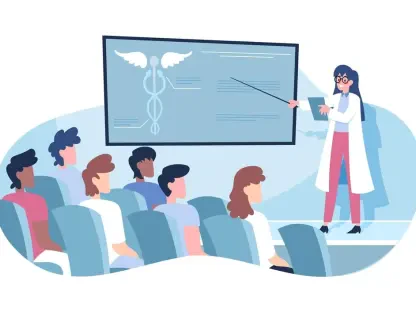I’m thrilled to sit down with Faisal Zain, a renowned healthcare expert with deep expertise in medical technology. With years of experience in the manufacturing of diagnostic and treatment devices, Faisal has been at the forefront of driving innovation in healthcare. Today, we’ll explore the transformative potential of artificial intelligence (AI) in healthcare delivery, the regulatory challenges that accompany its integration, and the balance between fostering innovation and ensuring patient safety. We’ll also dive into the financial burdens of administrative tasks, the need for synchronized policy frameworks, and strategies to remove barriers hindering AI adoption in hospitals and health systems.
How do you see AI reshaping the landscape of healthcare delivery in the coming years?
AI has the potential to revolutionize healthcare by streamlining processes and enhancing patient outcomes. From ambient listening tools that assist with clinical documentation to algorithms that aid in interpreting medical images, we’re already seeing AI reduce administrative burdens and improve diagnostic accuracy. Looking ahead, I believe AI will further personalize patient care through predictive analytics, helping clinicians anticipate health issues before they escalate. It’s about enabling providers to focus more on patients and less on paperwork, ultimately transforming how care is delivered across communities.
Can you share some real-world examples of AI making a tangible difference in hospitals today?
Absolutely. Many hospitals are using AI-driven chatbots for scheduling appointments and triaging patients, which saves time for both staff and patients. Another impactful application is in radiology, where AI algorithms assist in detecting abnormalities in X-rays or MRIs with remarkable precision, often catching details that might be missed in a busy setting. Additionally, some health systems use AI for clinical documentation, where ambient listening tech captures patient-provider conversations and turns them into structured notes. These tools are already easing workloads and improving efficiency on the ground.
What are the biggest hurdles in ensuring AI innovations don’t compromise patient safety?
One major hurdle is ensuring that AI tools are both accurate and unbiased. Many AI systems operate as a “black box,” making it hard to understand how decisions are reached, which can be risky in healthcare where lives are at stake. There’s also the challenge of data quality—AI relies on vast datasets, and if the data is flawed or skewed, the outcomes can be unreliable. Beyond that, we must ensure clinicians remain in the decision-making loop, especially for critical areas like insurance claims or treatment denials, to prevent automated errors from harming patients. Balancing rapid innovation with rigorous oversight is key.
Hospitals face significant financial strain from administrative tasks. How does this impact their ability to adopt new technologies like AI?
The financial strain is immense. Over a quarter of healthcare spending—more than $1 trillion annually—goes toward administrative tasks like billing and compliance. This burden often leaves hospitals, especially those with negative operating margins, with little room to invest in cutting-edge tech like AI. When nearly 40% of hospitals are struggling financially, many have to prioritize immediate survival over long-term innovation. This creates a vicious cycle where the very tools that could reduce costs, like AI, remain out of reach due to upfront investment needs.
How do excessive regulations contribute to these administrative challenges in healthcare?
Excessive regulations often mean hospitals must dedicate significant resources to compliance, diverting time and money from patient care. For instance, navigating a patchwork of state privacy laws alongside federal rules like HIPAA creates a complex web of requirements that demand constant attention and staff training. This regulatory overload not only increases costs but also slows down the adoption of AI tools, as hospitals must ensure every new system aligns with overlapping and sometimes contradictory mandates. It’s a heavy load that stifles efficiency.
Why is it critical to align AI policies with existing healthcare regulations like HIPAA or FDA guidelines?
Aligning AI policies with existing frameworks like HIPAA and FDA rules prevents unnecessary redundancy and confusion. These regulations already address core issues like patient privacy, cybersecurity, and device safety, which are directly relevant to AI applications. By integrating AI policies into these established structures, we can ensure a cohesive approach that doesn’t burden providers with duplicate or conflicting rules. It’s about building on a solid foundation rather than creating a separate, potentially clashing set of guidelines that could hinder adoption.
What are some regulatory barriers slowing down the rollout of AI tools in healthcare settings?
One significant barrier is the fragmented landscape of state privacy laws, which often conflict with federal standards like HIPAA. This inconsistency makes it tough for hospitals to share data across systems—a critical need for AI development. Another issue is outdated regulations like 42 CFR Part 2, which restrict access to substance use disorder data, limiting AI’s potential in behavioral health care. Additionally, proposed mandatory cybersecurity rules under HIPAA, such as unrealistic recovery timelines after breaches, add pressure without addressing root causes like third-party vulnerabilities. These barriers create hesitation and delay progress.
How does the inconsistency of state privacy laws pose challenges for hospitals using AI, and what solutions might address this?
The patchwork of state privacy laws creates a compliance nightmare for hospitals. When each state has different rules on how health data can be used or shared, it complicates the development of AI tools that rely on large, interoperable datasets. This inconsistency raises costs and risks legal missteps, diverting resources from patient care. A practical solution would be stronger federal preemption through HIPAA, establishing a uniform standard that balances privacy with the need for data sharing. This would simplify compliance and enable AI to thrive across state lines.
Why is it essential to have trained clinicians involved in AI-driven decisions, particularly for things like insurance claims or prior authorizations?
Having trained clinicians in the loop is crucial because AI, while powerful, lacks the nuanced judgment of human providers. In areas like insurance claims or prior authorizations, AI tools used by insurers have been linked to inappropriate denials of care, often prioritizing financial metrics over medical necessity. A clinician’s expertise ensures that decisions account for individual patient contexts that algorithms might overlook. This human oversight prevents errors, builds trust in AI systems, and ultimately protects access to necessary care.
Looking ahead, what is your forecast for the role of AI in healthcare over the next decade?
I’m optimistic that AI will become a cornerstone of healthcare within the next decade, fundamentally changing how we prevent, diagnose, and treat conditions. We’ll likely see AI deeply integrated into personalized medicine, predicting individual health risks with unprecedented accuracy. Administrative burdens should ease as AI automates more routine tasks, freeing up clinicians for direct patient care. However, this future hinges on overcoming current regulatory and infrastructural challenges, ensuring equitable access—especially in rural areas—and maintaining strict ethical standards. If we get the balance right, AI could usher in an era of more efficient, accessible, and patient-centered care.









